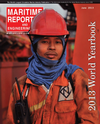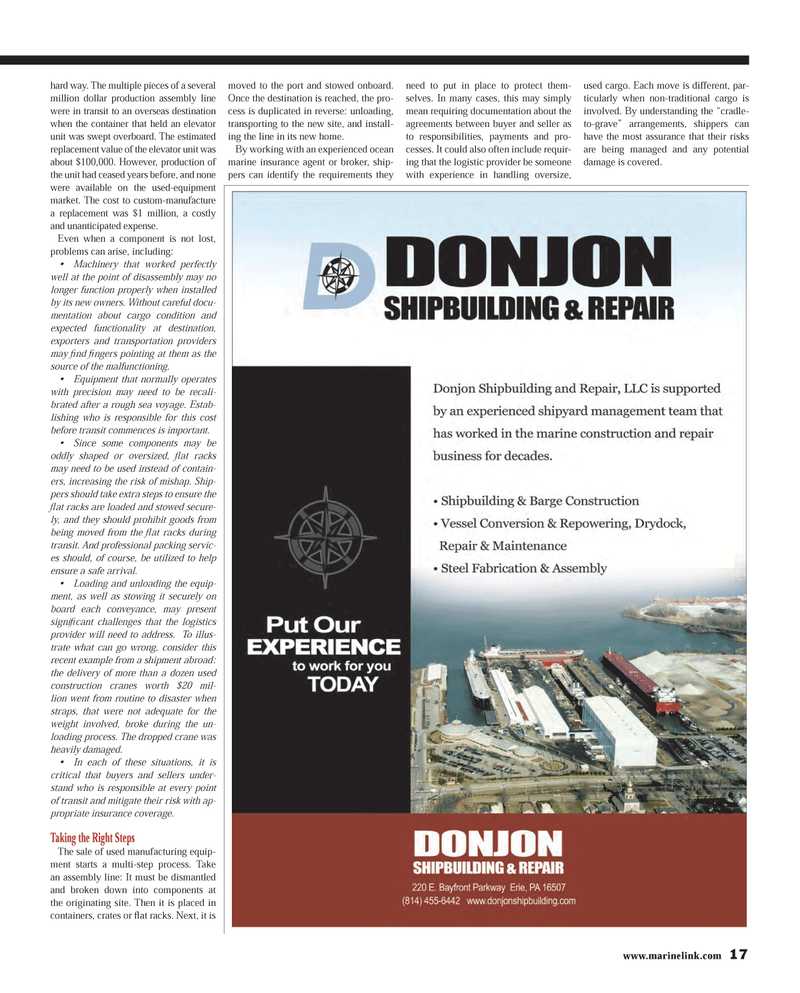
Page 17: of Maritime Reporter Magazine (June 2013)
Annual World Yearbook
Read this page in Pdf, Flash or Html5 edition of June 2013 Maritime Reporter Magazine
www.marinelink.com 17hard way. The multiple pieces of a several million dollar production assembly line were in transit to an overseas destination when the container that held an elevator unit was swept overboard. The estimated replacement value of the elevator unit was about $100,000. However, production of the unit had ceased years before, and none were available on the used-equipment market. The cost to custom-manufacture a replacement was $1 million, a costly and unanticipated expense.Even when a component is not lost, problems can arise, including:? Machinery that worked perfectly well at the point of disassembly may no longer function properly when installed by its new owners. Without careful docu- mentation about cargo condition and expected functionality at destination, exporters and transportation providers may Þ nd Þ ngers pointing at them as the source of the malfunctioning. ? Equipment that normally operates with precision may need to be recali- brated after a rough sea voyage. Estab- lishing who is responsible for this cost before transit commences is important. ? Since some components may be oddly shaped or oversized, ß at racks may need to be used instead of contain-ers, increasing the risk of mishap. Ship- pers should take extra steps to ensure the ß at racks are loaded and stowed secure- ly, and they should prohibit goods from being moved from the ß at racks during transit. And professional packing servic- es should, of course, be utilized to help ensure a safe arrival. ? Loading and unloading the equip- ment, as well as stowing it securely on board each conveyance, may present signiÞ cant challenges that the logistics provider will need to address. To illus- trate what can go wrong, consider this recent example from a shipment abroad: the delivery of more than a dozen used construction cranes worth $20 mil-lion went from routine to disaster when straps, that were not adequate for the weight involved, broke during the un- loading process. The dropped crane was heavily damaged. ? In each of these situations, it is critical that buyers and sellers under- stand who is responsible at every point of transit and mitigate their risk with ap-propriate insurance coverage. Taking the Right Steps The sale of used manufacturing equip-ment starts a multi-step process. Take an assembly line: It must be dismantled and broken down into components at the originating site. Then it is placed in containers, crates or ß at racks. Next, it is moved to the port and stowed onboard. Once the destination is reached, the pro-cess is duplicated in reverse: unloading, transporting to the new site, and install-ing the line in its new home.By working with an experienced ocean marine insurance agent or broker, ship- pers can identify the requirements they need to put in place to protect them-selves. In many cases, this may simply mean requiring documentation about the agreements between buyer and seller as to responsibilities, payments and pro-cesses. It could also often include requir- ing that the logistic provider be someone with experience in handling oversize, used cargo. Each move is different, par- ticularly when non-traditional cargo is involved. By understanding the ?cradle-to-grave? arrangements, shippers can have the most assurance that their risks are being managed and any potential damage is covered.MR #6 (10-17).indd 17MR #6 (10-17).indd 175/30/2013 12:02:50 PM5/30/2013 12:02:50 PM

 16
16

 18
18
